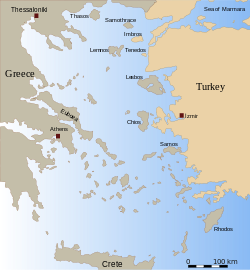Rhodes
| Rhodes Ρόδος |
|
|---|---|
 Palace of the Grand Master in the city of Rhodes |
|
| Geography | |
| Island chain: | Dodecanese |
| Area: | 1,400.684 km² (541 sq.mi.) |
| Highest mountain: | Mount Attavyros (1,216 m (3,990 ft)) |
| Government | |
| Periphery: | South Aegean |
| Prefecture: | Dodecanese |
| Capital: | Rhodes |
| Statistics | |
| Population: | 117,007 (as of 2001) |
| Density: | 84 /km² (216 /sq.mi.) |
| Postal code: | 85x xx |
| Area code: | 2241-2247 |
| License code: | ΡΟ |
| Website | |
| Rhodes City | |
Rhodes (Greek: Ρόδος, Ródos, [ˈroðos]) is a Greek island approximately 18 kilometres (11 mi) southwest of Turkey in the eastern Aegean Sea. It is the largest of the Dodecanese islands in terms of both land area and population, with a population of 117,007[1] of which 53,709 resided in the homonymous capital city of the island.
Historically, Rhodes was famous worldwide for the Colossus of Rhodes, one of the Seven Wonders of the World. The medieval Old Town of the City of Rhodes has been declared a World Heritage Site. The major industry is tourism.
Contents |
Other names
Rhodes is also called Italian: Rodi; Ottoman Turkish: ردوس Rodos; Ladino: Rodi or Rodes
Geography
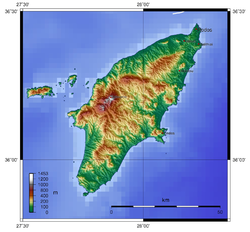
The island of Rhodes is shaped like a spearhead, 79.7 km (49.5 mi) long and 38 km (24 mi) wide, with a total area of approximately 1,400 square kilometres (541 sq mi) and a coastline of approximately 220 km (137 mi). The city of Rhodes is located at the northern tip of the island, as well as the site of the ancient and modern commercial harbours. The main air gateway (Diagoras International Airport, IATA code: RHO) is located 14 km (9 mi) to the southwest of the city in Paradisi. The road network radiates from the city along the east and west coasts.
In terms of flora and fauna, Rhodes is closer to Asia Minor than to the rest of Greece. The interior of the island is mountainous, sparsely inhabited and covered with forests of pine (Pinus brutia) and cypress (Cupressus sempervirens). The Rhodian population of fallow deer was found to be genetically distinct in 2005, and to be of urgent conservation concern.[2] In Petaludes Valley (Greek for "Valley of the Butterflies"), large numbers of tiger moths gather during the summer months. Mount Attavyros, at 1,216 metres (3,990 ft), is the island's highest point of elevation. While the shores are rocky, the island has arable strips of land where citrus fruit, wine grapes, vegetables, olives and other crops are grown.
Outside of the city of Rhodes, the island is dotted with small villages and beach resorts, among them Faliraki, Lindos, Kremasti, Haraki, Pefkos, Archangelos, Afantou, Koskinou, Embona (Attavyros), Paradisi, and Trianta (Ialysos). Tourism is the island's primary source of income.
Earthquakes
Earthquakes include the 226 BC earthquake that destroyed the Colossus of Rhodes; one on 3 May 1481 which destroyed much of the city of Rhodes;[3] and one on 26 June 1926.[4]
On 15 July 2008, Rhodes was struck by a 6.3 magnitude earthquake causing minor damage to a few old buildings. One woman lost her life when she fell down stairs while trying to flee her home.[5]
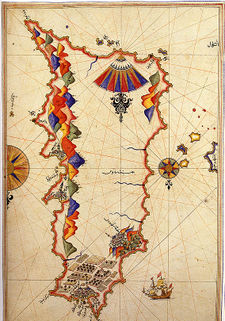
History
Ancient times
The island was inhabited in the Neolithic period, although little remains of this culture. In the 16th century BC the Minoans came to Rhodes. Later Greek mythology recalled a Rhodian race called the Telchines, and associated the island of Rhodes with Danaus; it was sometimes nicknamed Telchinis. In the 15th century BC, Mycenaean Greeks invaded. After the Bronze Age collapse the first renewed outside contacts are with Cyprus.[6] In the 8th century BC the island's settlements started to form, with the coming of the Dorians, who built the three important cities of Lindos, Ialyssos and Kameiros, which together with Kos, Cnidus and Halicarnassus (on the mainland) made up the so-called Dorian Hexapolis (Greek for six cities).
Before archaeology, myth stood in for blanks in the historical record. In Pindar's ode, the island was said to be born of the union of Helios the sun god and the nymph Rhode, and the cities were named for their three sons. The rhoda is a pink hibiscus native to the island. Diodorus Siculus added that Actis, one of the sons of Helios and Rhode, travelled to Egypt. He built the city of Heliopolis and taught the Egyptians the science of astrology.[7]
In the second half of the 8th century the sanctuary of Athena received votive gifts that are markers for cultural contacts: small ivories from the Near East and bronze objects from Syria. At Kameiros on the northwest coast, a former Bronze Age site, where the temple was founded in the 8th century, there is another notable contemporaneous sequence of carved ivory figurines. Phoenician presence on the island at Ialysos is attested in traditions recorded much later by Rhodian historians.

The Persians invaded and overran the island, but were in turn defeated by forces from Athens in 478 BC. The cities joined the Athenian League. When the Peloponnesian War broke out in 431 BC, Rhodes remained largely neutral, although it remained a member of the League. The war lasted until 404 BC, but by this time Rhodes had withdrawn entirely from the conflict and decided to go her own way.
In 408 BC the cities united to form one territory. They built the city of Rhodes, a new capital on the northern end of the island. Its regular plan was superintended by the Athenian architect Hippodamus. The Peloponnesian War had so weakened the entire Greek culture that it lay open to invasion. In 357 BC the island was conquered by the king Mausolus of Caria, then it fell to the Persians in 340 BC. Their rule was also short. To the great relief of its citizens, Rhodes became a part of the growing empire of Alexander the Great in 332 BC, after he defeated the Persians.
Following the death of Alexander his generals vied for control of the kingdom. Three: Ptolemy, Seleucus, and Antigonus, succeeded in dividing the kingdom among themselves. Rhodes formed strong commercial and cultural ties with the Ptolemies in Alexandria, and together formed the Rhodo-Egyptian alliance that controlled trade throughout the Aegean in the 3rd century BC. The city developed into a maritime, commercial and cultural center; its coins circulated nearly everywhere in the Mediterranean. Its famous schools of philosophy, science, literature and rhetoric shared masters with Alexandria: the Athenian rhetorician Aeschines, who formed a school at Rhodes; Apollonius of Rhodes; the observations and works of the astronomers Hipparchus and Geminus, the rhetorician Dionysios Trax. Its school of sculptors developed a rich, dramatic style that can be characterized as "Hellenistic Baroque".
In 305 BC, Antigonus directed his son, Demetrius, to besiege Rhodes in an attempt to break its alliance with Egypt. Demetrius created huge siege engines, including a 180 ft (55 m) battering ram and a siege tower named Helepolis that weighed 360,000 pounds (163,293 kg). Despite this engagement, in 304 BC after only one year, he relented and signed a peace agreement, leaving behind a huge store of military equipment. The Rhodians sold the equipment and used the money to erect a statue of their sun god, Helios, the statue since called the Colossus of Rhodes.
In 164 BC, Rhodes signed a treaty with Rome. It became an educational center for Roman noble families, and was especially noted for its teachers of rhetoric, such as Hermagoras and the unknown author of Rhetorica ad Herennium. At first the state was an important ally of Rome and enjoyed numerous privileges, but these were later lost in various machinations of Roman politics. Cassius eventually invaded the island and sacked the city.

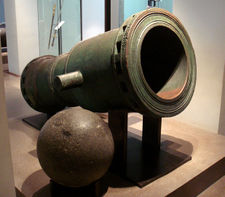
In the 1st century AD, the Emperor Tiberius spent a brief term of exile on Rhodes. Saint Paul brought Christianity to people on the island.[8] Rhodes reached her zenith in the 3rd century. In 395, the long Byzantine Empire-period began for Rhodes, when the eastern half of the Roman empire became gradually more Greek.
Rhodes was occupied by the Muslim forces of Muawiyah I in 672. In circa 1090 it was occupied by the Muslim forces of the Seljuk Turks, not long after the Battle of Manzikert.[9] Rhodes was recaptured by the Byzantine Emperor Alexius I Comnenus during the First Crusade.
Medieval period
Further information: Siege of Rhodes (1480), Siege of Rhodes (1522)
In 1309 the Byzantine era came to an end when the island was occupied by forces of the Knights Hospitaller. Under the rule of the newly named "Knights of Rhodes", the city was rebuilt into a model of the European medieval ideal. Many of the city's famous monuments, including the Palace of the Grand Master, were built during this period.
The strong walls which the Knights had built withstood the attacks of the Sultan of Egypt in 1444, and of Mehmed II in 1480. Ultimately, however, Rhodes fell to the large army of Suleiman the Magnificent in December 1522, long after the rest of the Byzantine empire had been lost. The few surviving Knights were permitted to retire to the Kingdom of Sicily. The Knights would later move their base of operations to Malta. The island was thereafter a possession of the Ottoman Empire for nearly four centuries.
Modern history
The island was populated by ethnic groups from the surrounding nations, including Jews. Under the Ottoman Empire rule, they generally did fairly well, but discrimination and bigotry occasionally arose. In February 1840, the Jews of Rhodes were falsely accused of ritually murdering a Christian boy. This became known as the Rhodes blood libel.
In 1912, Italy seized Rhodes from the Turks. The island's population thus bypassed many of the events associated with the "exchange of the minorities" between Greece and Turkey. Due to the Treaty of Lausanne, the island, together with the Dodecanese, was officially assigned to Italy. It became the core of their possession of the Isole Italiane dell'Egeo.
Following the Italian Armistice of 8 September 1943, the British attempted to get the Italian garrison on Rhodes to change sides. This was anticipated by the German Army, which succeeded in occupying the island. In great measure, the German occupation caused the British failure in the subsequent Dodecanese Campaign.
On 19 July 1944 the Gestapo rounded up the island’s nearly 2000 Jewish inhabitants, to send them to extermination camps. About 160 of the island's more than 600 Greek Jews survived. The Turkish Consul Selahattin Ülkümen succeeded, at considerable risk to himself and his family, in saving 42 Jewish families, about 200 persons in total, who had Turkish citizenship or were family members of Turkish citizens.
In 1948, together with the other islands of the Dodecanese, Rhodes was united with Greece.
In 1949, Rhodes was the venue for negotiations between Israel and Egypt, Jordan, Lebanon, and Syria, concluding with the 1949 Armistice Agreements.
Archaeology
In ancient times, Rhodes was home to one of the Seven Wonders of the World—the Colossus of Rhodes. This giant bronze statue was documented as once standing at the harbour. It was completed in 280 BC but was destroyed in an earthquake in 224 BC. No trace of the statue remains today.
Historical sites on the island of Rhodes include the Acropolis of Lindos, the Acropolis of Rhodes, the Temple of Apollo, ancient Ialysos, ancient Kamiros, the Governor's Palace, Rhodes Old Town (walled medieval city), the Palace of the Grand Masters, Kahal Shalom Synagogue in the Jewish Quarter, the Archeological Museum, the ruins of the castle of Monolithos, the castle of Kritinia and St. Catherine Hospice.
Religion
The predominant religion is Greek Orthodox. There is a significant Roman Catholic[10] minority on the island, many of whom are descendants of Italians who remained after the end of the Italian occupation. Rhodes has a Muslim minority, a remnant from Ottoman Turkish times.
The Jewish community of Rhodes[11] goes back to the 1st century AD. In 1480, the Jews actively defended the walled city against the Turks. Kahal Shalom, established in 1557, is the oldest synagogue in Greece and still stands in the Jewish quarter of the Old Town of Rhodes.
At its peak in the 1920s, the Jewish community was one-third of the total population.[12] In the 1940s, there were about 2000 Jews of various ethnic backgrounds. The Germans deported and killed most of the community during the Holocaust. Kahal Shalom has been renovated with the help of foreign donors but few Jews live year-round in Rhodes today, so services are not held on a regular basis.[13]




Government
Rhodes is the capital of the Dodecanese Prefecture and the most populated island of the South Aegean Region. The local association of municipalities and communities of the Dodecanese, TEDKD,[14] is responsible for the administration of the island and the prefecture as a whole.
Administrative divisions
The island is divided into 10 municipalities:
| Municipality | Population | Seat | Municipal Departments | Postal code |
|---|---|---|---|---|
| Afantou | 6,712 | Afantou | Afantou, Kolympia, Archipoli | 851 03 |
| Archangelos | 7,779 | Archangelos | Archangelos, Malona, Charaki, Massari | 851 02 |
| Attavyros | 2,635 | Empona | Empona, Kritinia, Monolithos, Sianna, Ag. Isidoros | 851 09 |
| Ialysos | 10,107 | Ialysos | Ialysos | 851 01 |
| Kallithea | 10,251 | Kalythies | Kalythies, Koskinou, Faliraki, Psinthos | 851 05 |
| Kameiros | 5,145 | Soroni | Soroni, Apollona, Dimylia, Kalavarda, Platania, Salakos, Fanes | 851 06 |
| Lindos | 3,633 | Lindos | Lindos, Kalathos, Laerma, Lardos, Pylona | 851 07 |
| Petaloudes | 12,133 | Kremasti | Kremasti, Pastida, Maritsa, Paradeisi, Theologos, Damatria | 851 04 |
| Rhodes | 54,000 | Rhodes City | Rhodes City | 851 00 |
| South Rhodes | 4,313 | Gennadi | Gennadi, Apolakkia, Arnitha, Askleipio, Vati, Istrios, Kattavia, Lachania, Mesanagros, Profylia | 851 09 |
Towns and villages
Rhodes has 43 towns and villages:
| Town/Village | Population | Municipality | Town/Village | Population | Municipality |
|---|---|---|---|---|---|
| Rhodes City | 80,000 | Rhodes | Gennadi | 655 | South Rhodes |
| Ialysos | 15,000 | Ialysos | Salakos | 607 | Kamiros |
| Afantou | 5,933 | Afantou | Kritinia | 606 | Attavyros |
| Kalythies | 5,861 | Kallithea | Kattavia | 590 | South Rhodes |
| Archangelos | 5,752 | Archangelos | Dimylia | 515 | Kamiros |
| Kremasti | 4,585 | Petaloudes | Kalavarda | 512 | Kamiros |
| Koskinou | 3,224 | Kallithea | Pylona | 504 | Lindos |
| Paradeisi | 2,646 | Petaloudes | Istrios | 485 | South Rhodes |
| Pastida | 1,803 | Petaloudes | Damatria | 477 | Petaloudes |
| Maritsa | 1,766 | Petaloudes | Laerma | 446 | South Rhodes |
| Empona | 1,451 | Attavyros | Apolakkia | 415 | South Rhodes |
| Soroni | 1,236 | Kamiros | Platania | 383 | Kamiros |
| Lardos | 1,212 | Lindos | Kalathos | 380 | Lindos |
| Psinthos | 1,166 | Kallithea | Lachania | 341 | South Rhodes |
| Malona | 1,096 | Archangelos | Monolithos | 334 | Attavyros |
| Lindos | 1,091 | Lindos | Mesanagros | 330 | South Rhodes |
| Apollona | 997 | Kamiros | Profilia | 326 | South Rhodes |
| Massari | 931 | Archangelos | Arnitha | 310 | South Rhodes |
| Fanes | 895 | Kamiros | Sianna | 244 | Attavyros |
| Theologos | 856 | Petaloudes | Vati | 188 | South Rhodes |
| Archipoli | 779 | Afantou | Agios Isidoros | Attavyros | |
| Askleipio | 673 | South Rhodes |
Economy
The economy is tourist-oriented. The most developed sector is service. Small industries process imported raw materials for local retail. Other industry includes agricultural goods production, stockbreeding, fishery and winery.
Transportation
Road network
The road network of the island is mostly modern and paved. There are four major arteries:
- Rhodes-Kamiros Province Avenue: Two lane, runs through the west coast north to south and connects Rhodes City with Diagoras Airport and Kamiros.
- Rhodes-Lindos National Avenue (Greek National Road 95): Four and two lane, runs mainly inland north to south and connects Rhodes City with Lindos.
- Rhodes-Kallithea Province Avenue: Two lane, runs through the east coast north to south and connects Rhodes City with Faliraki Resort.
- Tsairi-Airport National Avenue: Four and two lane, runs inland east to west and connects the east coast with the west and the airport.
Future roads:
- Further widening of E-95 from Faliraki to Lindos. This is to be four lane with jersey barrier in the middle,about 36 km (22 mi) in length, with the first part scheduled to start in August 2007.
- Plans also exist for a new four lane express road connecting Rhodes Town with Diagoras Airport that will reduce congestion on the coastal west avenue
- The first phase of construction of the Rhodes City ringway was begun a few years ago, but progress has been slow.
Cars and motorbikes
Families in Rhodes often own more than one car, along with a motorbike. Traffic jams are common particularly in the summer months. The island is served by 450 taxis.
Bus
Bus services are handled by two operators:
- RODA: Rhodes City company that also services suburban areas (Faliraki, Ialysos, Kremasti, Airport, Pastida, Maritsa, Paradeisi) and the entire west coast (blue-white colored).
- KTEL: State-owned buses that serve villages and resorts in the east coast (yellow-orange colored).
Air
Rhodes has three airports but only one is public. Diagoras Airport, one of the biggest in Greece, is the main entrance/exit point for both locals and tourists. The island is well connected with other major Greek cities and islands as well as with major European capitals and cities via charter flights.
- Diagoras International Airport: public airport, 16 km (10 mi) south west of Rhodes City, third in international passenger volume and fourth in total passenger volume in Greece.
- Maritsa Air Force Airfield: closed to public, near Maritsa village, used to be the public airport of the island until 1977. Nowadays serves the Greek Army and is sometimes used for car races.
- Kalathos Air Strip: served as a landing strip during World War II, near the village of Kalathos. Inoperative.
Two pilot schools offer aviation services (small plane rental, island hopping).
Sea
Rhodes has five ports, three of them in Rhodes City, one in the west coast near Kamiros and one in east coast near Lardos.
- Central Port: located in the city of Rhodes serves domestic and international traffic.
- Kolona Port: opposite the central port, serves intra-Dodecanese traffic and large yachts.
- Akandia Port: the new port of the island next to the central port, being built since 1960s, for domestic and international traffic. At the moment serves cruise ships on peak days.
- Kamiros Skala Dock: 30 km (19 mi) south west of the city near Ancient Kamiros ruins serves mainly the island of Halki
- Lardos Dock: formerly servicing local industries, now under development as an alternative port for times when the central port is inaccessible due to weather conditions. It is situated in a rocky shore near the village of Lardos in south east Rhodes.
Culture
Sports
- Football: AS Rodos and Diagoras F.C., both Rhodes City based teams, compete professionally at the national level. Local football leagues (organized at the prefecture level) contain three divisions with more than 50 teams. Many stadiums are grass covered.
- Basketball: Colossus BC sponsors professional basketball and has joined the Greek A1 League. The local league includes two divisions with 14 teams. Two indoor courts exist in Rhodes City, and one each in Ialysos and Kremasti. Several other are planned for Rhodes City Pales De Sports, Faliraki, Afantou, and South Rhodes.
- Volleyball: local teams only.
- Water Polo: mostly amateur based. There is no single indoor pool on the island.
- Rugby: introduced in 2007. Teams compete at the national level.
- Tennis: tennis has a long history on the island.
- Sailing: widely developed, offers competition at the international level.
- Cycling: for a long period of time Rhodes had the only cycling track in Greece, producing Olympics level competitors.
- Rhodes competes in the bi-annual Island Games, which it hosted in 2007.[15]
In popular culture
- In ancient times there was a Roman saying: "Hic Rhodus, hic salta!"—"Rhodes is here, here perform your jump", an admonition to prove one's idle boasts by deed rather than talk. It comes from an Aesop's fable called "The Boastful Athlete", and was cited by Hegel and Marx.
- Many of the outdoor scenes of The Guns of Navarone (starring Gregory Peck, David Niven and Anthony Quinn) and Escape to Athena (starring Roger Moore and Telly Savalas) were filmed on the Island of Rhodes.
- In the PlayStation 2 game God of War II, both Rhodes and the Colossus of Rhodes are featured at the start of the game, offering a mythological theory as to how the Colossus was destroyed. The Colossus of Rhodes is a common feature in many games, for example, it can be built as a "Wonder" in Rise of Nations and the Civilization series of games.
- In one book of the Roman Mysteries series of children's novels, by Caroline Lawrence, the main characters visit Rhodes to stop the trading of slave labour.
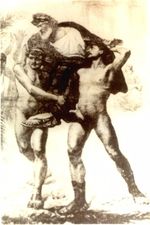
Notable people
- Agesander, (1st century BC) sculptor
- Chares of Lindos (3rd century BC), sculptor
- Cleobulus of Lindos (6th century BC), philosopher and one of the Seven Sages of Ancient Greece
- Diagoras of Rhodes (5th century BC), boxer, multiple Olympic winner
- Dinocrates (4th century BC), architect and technical adviser for Alexander the Great
- Leonidas, (2nd century BC) athlete
- Memnon (380–333 BC), commander of mercenary army
International relations
Twin towns — Sister cities
 Perth, Western Australia, Australia
Perth, Western Australia, Australia
Gallery
 West coast and the town of Ialysos from Filerimos hill |
 Filerimos hill |
Filerimos |
The Aghios Archangelos Church in the city of Archangelos. |
 Church in Sianna village, on the west coast |
Tsampika beach on the east coast |
|
Kallithea thermes (spa) |
Lindos—Akropolis |
Small church in Lindos town |
Rhodes town—Old Town gardens |
Rhodes town—ancient Olympic stadium |
Romanic basilica in Old Town of Rhodes |
References
- Notes
- ↑ As of 2001
- ↑ Marco, M; Cavallaro, A; Pecchioli, E & Vernesi, C (2006-11-11), "Artificial Occurrence of the Fallow Deer, Dama dama dama (L., 1758), on the Island of Rhodes (Greece): Insight from mtDNA Analysis", Human Evolution 21, No. 2: 167–175, doi:10.1007/s11598-006-9014-9, http://www.springerlink.com/content/u406m764gm435u82/
- ↑ "Rhodes, Greece, 1481" Jan Kozak Collection: KZ13, The Earthquake Engineering Online Archive
- ↑ Ambraseys, N. N. and Adams, R. D. (1998) "The Rhodes earthquake of 26 June 1926" Journal of Seismology 2(3): pp. 267–292.
- ↑ "Earthquake's aftermath", Discover Rhodes. Retrieved 16 July 2008.
- ↑ B. d'Agostino, "Funerary customs and society on Rhodes in the Geometric Period: some observations", in E. Herring and I. Lemos, eds. Across Frontiers: Etruscans, Greeks, Phoenicians and Cypriots. Studies in Honour of D. Ridgway and F.R. Serra Ridgway 2006:57-69.
- ↑ ''The Historical Library of Diodorus Siculus'', Book V, ch.III. Books.google.com. http://books.google.com/books?id=agd-eLVNRMMC&printsec=titlepage#PPA336,M1. Retrieved 2010-01-24.
- ↑ See Acts 21.
- ↑ Brownworth, Lars (2009) Lost to the West: The Forgotten Byzantine Empire That Rescued Western Civilization, Crown Publishers, ISBN 978-0307407955: ". . . the Muslims captured Ephesus in 1090 and spread out to the Greek islands. Chios, Rhodes, and Lesbos fell in quick succession." p. 233.
- ↑ "Καθολικη Εκκλησια Τησ Ροδου". Catholicchurchrhodes.com. http://www.catholicchurchrhodes.com. Retrieved 2009-03-22.
- ↑ See Angel, Marc. The Jews of Rhodes: The History of a Sephardic Community. Sepher-Hermon Press Inc. and The Union of Sephardic Congregations. New York: 1978 (1st ed.), 1980 (2nd ed.), 1998 (3rd ed.).
- ↑ "History of Jewish Greece". Jewishvirtuallibrary.org. http://www.jewishvirtuallibrary.org/jsource/vjw/Greece.html. Retrieved 2010-01-24.
- ↑ "The Virtual Jewish History Tour — Greece". Jewishvirtuallibrary.org. http://www.jewishvirtuallibrary.org/jsource/vjw/Greece.html. Retrieved 2010-01-24.
- ↑ "Municipal Association". Tedkd.gr. http://www.tedkd.gr. Retrieved 2010-01-24.
- ↑ International Island Games Association website. Retrieved 27Jun08.
External links
- City of Rhodes official website
- Rhodes travel guide from Wikitravel
|
||||||||||||||||||||||||||||||||||||||||||||||||||||||||||||||||
